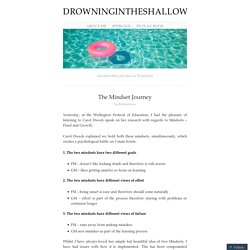

The Secret to Raising Smart Kids. A brilliant student, Jonathan sailed through grade school.

He completed his assignments easily and routinely earned As. Jonathan puzzled over why some of his classmates struggled, and his parents told him he had a special gift. In the seventh grade, however, Jonathan suddenly lost interest in school, refusing to do homework or study for tests. As a consequence, his grades plummeted. His parents tried to boost their son's confidence by assuring him that he was very smart. Our society worships talent, and many people assume that possessing superior intelligence or ability—along with confidence in that ability—is a recipe for success. The result plays out in children like Jonathan, who coast through the early grades under the dangerous notion that no-effort academic achievement defines them as smart or gifted. People can learn to be helpless, too, but not everyone reacts to setbacks this way.
Others, meanwhile, focused on fixing errors and honing their skills. You did a good job drawing. Growth Mindset Activites & Assignments. Growth Mindset: Clearing up Some Common Confusions. By Eduardo Briceño A growth mindset is the understanding that personal qualities and abilities can change. It leads people to take on challenges, persevere in the face of setbacks, and become more effective learners. As more and more people learn about the growth mindset, which was first discovered by Stanford Professor Carol Dweck, we sometimes observe some confusions about it.
Recently some critiques have emerged. Of course we invite critical analysis and feedback, as it helps all of us learn and improve, but some of the recent commentary seems to point to misunderstandings of growth mindset research and practice. Confusion #1: What a growth mindset is When we ask people to tell us what the growth mindset is, we often get lots of different answers, such as working hard, having high expectations, being resilient, or more general ideas like being open or flexible.
Confusion #2: To foster a growth mindset, simply praise children for working hard Deepening our understanding over time. How To Weave Growth Mindset Into School Culture. Adilene Rodriguez admits she has always struggled with academics.

Especially in middle school she hated getting up early, found her classes boring and didn’t really see where it was all going. When she started her freshman year at Arroyo High School in San Lorenzo, California, just south of Oakland, she was a shy student who rarely spoke up in class and had little confidence in herself as a scholar.
Rodriguez is now a senior and her approach to school has changed dramatically over her high school career. She attributes her shift to her freshman science teacher, Jim Clark, who taught the class about growth mindset from the very beginning and backed up the discussion with action. “He would tell me, ‘You need to push yourself, that’s how you’re going to grow. She didn’t believe him at first; she thought she just wasn’t good at science. When Clark suggested Rodriguez take AP biology she resisted, scared she’d be unprepared for the challenge. Untitled. 7 Ways to Confront Failure Like an Innovator. Household appliances aren’t the most exciting items on the market, but brilliant inventors still manage to turn them into big hits.

James Dyson introduced his first bagless vacuum cleaner in 1993. Fifty models and millions of sales later, Dyson is the leader in innovative and creative household appliances. Here are seven valuable takeaways from how the British inventor went from being a guy frustrated with his vacuum cleaner to one of the world’s most successful entrepreneurs. 1. Figure out what frustrates you. Dyson invented his trademark vacuum cleaner because, while every manufacturer claimed that their vacuum cleaners were the world’s most powerful, he was dissatisfied with the performance of every single model on the market. 2.
Dyson told The Guardian that frustration doesn’t just drive his process of invention–it drives his sales pitches. 3. If you think that Dyson got it right on the first try, you’re wrong. Drowningintheshallow. Yesterday, at the Wellington Festival of Education, I had the pleasure of listening to Carol Dweck speak on her research with regards to Mindsets – Fixed and Growth.

Carol Dweck explained we hold both these mindsets, simultaneously, which creates a psychological battle on 3 main fronts: 1. The two mindsets have two different goals FM – doesn’t like looking dumb and therefore is risk averseGM – likes getting smarter so focus on learning 2. FM – being smart is easy and therefore should come naturallyGM – effort is part of the process therefore staying with problems or confusion longer 3. FM – runs away from making mistakesGM sees mistakes as part of the learning process Whilst I have always loved her simple but beautiful idea of two Mindsets, I have had issues with how it is implemented.
This, Dweck informs us, misses the key point of the Growth Mindset. So how do we begin this journey? Dweck suggested we name our triggers, so we become intimate and aware of them.